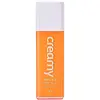Creamy Vitamina C Versus FaceTheory Amil-C Whip M5
What's inside
What's inside
 Key Ingredients
Key Ingredients

 Benefits
Benefits

 Concerns
Concerns

 Ingredients Side-by-side
Ingredients Side-by-side

Water
Skin ConditioningAscorbyl Glucoside
AntioxidantDipropylene Glycol
HumectantGlycerin
HumectantEthoxydiglycol
Humectant3-O-Ethyl Ascorbic Acid
Skin ConditioningTocopheryl Acetate
AntioxidantXanthan Gum
EmulsifyingFerulic Acid
AntimicrobialSclerotium Gum
Emulsion StabilisingLecithin
EmollientPhenoxyethanol
PreservativePullulan
Silica
AbrasiveEthylhexylglycerin
Skin ConditioningSodium Hyaluronate
HumectantWater
Skin ConditioningNiacinamide
SmoothingC15-19 Alkane
SolventCetyl Alcohol
EmollientGlyceryl Stearate Se
EmulsifyingPolyglyceryl-6 Stearate
EmollientHydroxystearic Acid
CleansingRosa Canina Seed Oil
EmollientCucurbita Pepo Seed Oil
EmollientTocopherol
AntioxidantGlycerin
HumectantSodium Anisate
AntimicrobialSodium Levulinate
Skin ConditioningSodium Ascorbyl Phosphate
AntioxidantCorn Starch Modified
AbsorbentGlyceryl Caprylate
Emollient3-O-Ethyl Ascorbic Acid
Skin ConditioningGellan Gum
Polyglyceryl-6 Behenate
Emulsion StabilisingSodium Phytate
Citrus Bergamia Peel Oil Expressed 0.226%
PerfumingWater, Niacinamide, C15-19 Alkane, Cetyl Alcohol, Glyceryl Stearate Se, Polyglyceryl-6 Stearate, Hydroxystearic Acid, Rosa Canina Seed Oil, Cucurbita Pepo Seed Oil, Tocopherol, Glycerin, Sodium Anisate, Sodium Levulinate, Sodium Ascorbyl Phosphate, Corn Starch Modified, Glyceryl Caprylate, 3-O-Ethyl Ascorbic Acid, Gellan Gum, Polyglyceryl-6 Behenate, Sodium Phytate, Citrus Bergamia Peel Oil Expressed 0.226%
Ingredients Explained
These ingredients are found in both products.
Ingredients higher up in an ingredient list are typically present in a larger amount.
You might know this ingredient as Ethyl Ascorbic Acid, a more stable version of ascorbic acid.
Like other types of vitamin C, this ingredient has many benefits including reducing wrinkles, skin soothing, dark spot fading, and fighting against free radicals.
3-O-Ethyl Ascorbic Acid interferes with the process of skin darkening, helping to reduce hyperpigmentation. It also encourages the skin to produce more collagen.
Once applied, 3-O-Ethyl Ascorbic Acid is converted to Vitamin C deeper in the skin's layers. This process is slow but makes this ingredient more tolerable for skin.
The optimum pH range for this ingredient is 4 - 5.5
Learn more about 3-O-Ethyl Ascorbic AcidGlycerin is already naturally found in your skin. It helps moisturize and protect your skin.
A study from 2016 found glycerin to be more effective as a humectant than AHAs and hyaluronic acid.
As a humectant, it helps the skin stay hydrated by pulling moisture to your skin. The low molecular weight of glycerin allows it to pull moisture into the deeper layers of your skin.
Hydrated skin improves your skin barrier; Your skin barrier helps protect against irritants and bacteria.
Glycerin has also been found to have antimicrobial and antiviral properties. Due to these properties, glycerin is often used in wound and burn treatments.
In cosmetics, glycerin is usually derived from plants such as soybean or palm. However, it can also be sourced from animals, such as tallow or animal fat.
This ingredient is organic, colorless, odorless, and non-toxic.
Glycerin is the name for this ingredient in American English. British English uses Glycerol/Glycerine.
Learn more about GlycerinWater. It's the most common cosmetic ingredient of all. You'll usually see it at the top of ingredient lists, meaning that it makes up the largest part of the product.
So why is it so popular? Water most often acts as a solvent - this means that it helps dissolve other ingredients into the formulation.
You'll also recognize water as that liquid we all need to stay alive. If you see this, drink a glass of water. Stay hydrated!
Learn more about Water